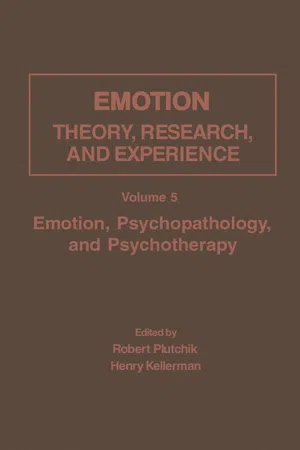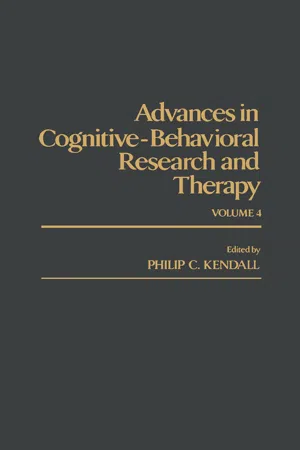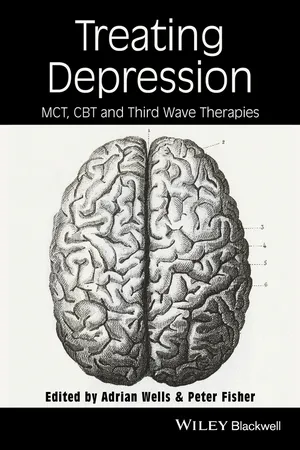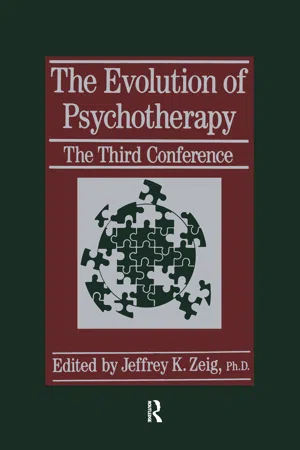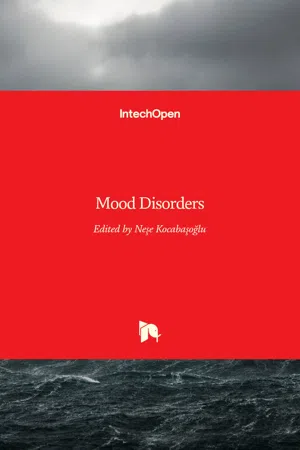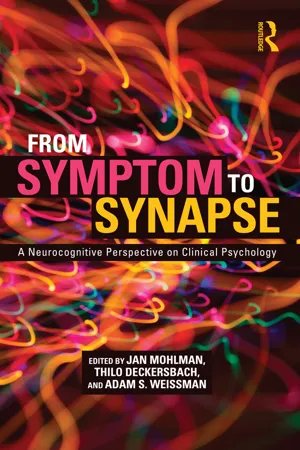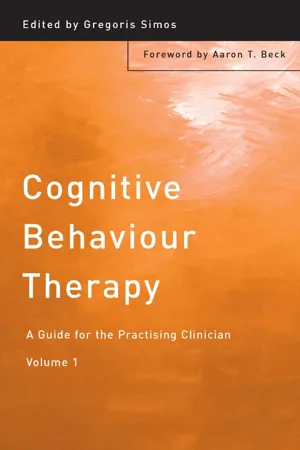Psychology
Cognitive Approach to Depression
The cognitive approach to depression focuses on how an individual's thoughts and beliefs contribute to the development and maintenance of depressive symptoms. It emphasizes the role of negative thought patterns, such as cognitive distortions and self-critical beliefs, in influencing mood and behavior. This approach also involves identifying and challenging maladaptive thought processes to alleviate depressive symptoms.
Written by Perlego with AI-assistance
Related key terms
1 of 5
11 Key excerpts on "Cognitive Approach to Depression"
- eBook - ePub
Coping with Depression
A Guide to What Works for Patients, Carers, and Professionals
- Costas Papageorgiou, Hannah Goring, Justin Haslam(Authors)
- 2011(Publication Date)
- Oneworld Publications(Publisher)
6Changing how you feel by changing what you think
In the previous chapter, we outlined behavioural theories of depression and methods of behavioural activation as a way of changing how you feel. Behavioural methods can be very effective in improving one’s mood and lifting one out of depression. For many people, however, it is also beneficial to focus on changing the negative thinking that accompanies depression, which is the topic of this chapter. Therapy focused on changing what we think is known as cognitive therapy and is based on cognitive theories of depression. The word ‘cognitive’ simply means ‘relating to thought’, while a cognition is a thought or mental process. One of the most widely known types of psychological therapy for depression is cognitive behavioural therapy (CBT), which combines both cognitive and behavioural techniques into an integrated whole. In this chapter, we outline cognitive theories of depression before going on to describe some of the methods used in cognitive therapy to change how you feel by changing what you think. We provide enough detail for you to be able to try some of these techniques for yourself. Many people gain relief by using these strategies independently as a form of self-help. However, other people (like the author of chapter 1 of this book) found it more beneficial to work with a qualified clinical psychologist or healthcare professional.Cognitive theories of depression
Cognitive theories of depression are based on the idea that what we think influences our mood. Within this view, it is not events in themselves that lead to emotions such as depression but our interpretations of and thoughts about these events. The following example illustrates this idea. Imagine that you wake up one morning, look out of the window and see that it has snowed during the night, blanketing the roads and countryside in several inches of snow. How might you feel? There are several possibilities. You might feel a surge of excitement and happiness, picturing yourself going sledging or building a snowman with your children. On the other hand, you might start anticipating driving to work, thinking, ‘Oh no, I won’t be able to drive safely in these conditions. I might skid and crash the car! But I can’t stay at home or my boss won’t be happy and might sack me! What am I going to do?’ In this case you would probably be feeling quite anxious. Or you might instead think, ‘Nobody will want to go out in this weather. I won’t be able to meet my friends today as we had planned. I was really looking forward to it; it’ll probably be a long time before we can arrange to meet up again.’ In this case you might feel sad. The point is, the fact that it has snowed does not in itself lead to excitement, anxiety or sadness; it is our interpretations or thoughts about what this means to us that leads to our emotions, as shown in box 6.1 - eBook - PDF
- Robert Plutchik, Henry Kellerman, Robert Plutchik, Henry Kellerman(Authors)
- 2013(Publication Date)
- Academic Press(Publisher)
Part III COGNITIVE, BEHAVIORAL, AND DYNAMIC FOCUS This page intentionally left blank Chapter 8 COGNITIVE APPROACHES TO PSYCHOTHERAPY: THEORY AND THERAPY MICHAEL S. GREENBERG AND AARON T. BECK ABSTRACT According to the cognitive model of emotional disorders, individuals suffering from a variety of emotional disorders can be characterized as possessing enduring and maladap-tive cognitive organizations or schémas that have a strong impact upon affective and behavioral responses. These schémas become activated as the psychological disturbance begins and lead to systematically biased conclusions about the self, the world, and the future. This process, in turn, is hypothesized to maintain and exacerbate the existing psychological disturbance. Further, it is proposed that different psychological disorders can be distinguished on the basis of their ideation, with depressive schémas typically containing themes of failure, worthlessness, incompetence, and rejection, whereas anx-iety disorders often contain themes of threat, danger, and uncertainty. Cognitive therapy is an active and structured approach to the treatment of depression and anxiety that is based upon the cognitive model of psychopathology. Patients are trained to systematically identify, evaluate, and test the reality of their biased or distorted cognitions. The patient in cognitive therapy is encouraged to view negative cognitions as hypotheses to be tested in relation to facts about the self, the world, and the future. This goal is achieved by a variety of cognitive and behavioral methods designed ultimately to reduce the symptoms of depression and anxiety and minimize the probability of relapse. Outcome studies have generally shown cognitive therapy to be an effective treatment, with the strongest evi-dence indicating cognitive therapy to be superior to nondirective and behavior therapies and at least as effective as chemotherapy. - eBook - PDF
- Philip C. Kendall(Author)
- 2013(Publication Date)
- Academic Press(Publisher)
There are a host of other important limitations, some conceptual and some methodological, and an excellent review by Coyne and Gotlib (1983) discusses many of these. For emphasis, however, two raised here and elsewhere need to be reiterated. One is the need for dis-tinguishing between processes that may account for depression onsets, and those that may account for depression maintenance. As indicated, several of the cognitive approaches appear to be more fully compatible with the idea that depressive thinking is a symptom of depression which may intensify and maintain dysphoria, rather than a primary cause. Persons who show relatively high levels of apparent depressive thinking on paper and pencil tests seem to be the most persistently Predicting Depression 61 depressed (e.g., Hamilton & Abramson, 1983; Lewinsohn et ai., 1981). Other studies indicated that depressive cognitions and schémas are a concomitant of depression that are not detected in the nondepressed state (e.g., Hamilton & Abramson, 1983; Hammen et αϊ., 1984a; Kuiper et αϊ., 1985). A second and related issue is the need for differentiating between chronic depressives and those who may show only a single depressive episode in response to stressful circumstances. It appears that the best predictor of future depression is past depression, and models which begin to account for the possible role of depression as a vulnerability factor itself should be pursued (e.g., Teasdale, 1983; Ham-men et al., 1984b). Β. Contributions of Cognitive-Behavioral Perspectives It may be apparent by now that the models reviewed share some important commonalities or potentials which are highly compatible with a cognitive-behavioral perspective. - eBook - ePub
Treating Depression
MCT, CBT, and Third Wave Therapies
- Adrian Wells, Peter Fisher, Adrian Wells, Peter Fisher(Authors)
- 2015(Publication Date)
- Wiley-Blackwell(Publisher)
Taken together, these early comparative trials provided the initial building blocks for an evidence base of behavioural and activation-oriented treatments for depressed individuals. Although the methodological rigor of many of these early studies was often lacking, they highlighted the promise of such interventions. The development of this evidence base was, however, stalled, as burgeoning interest in cognitive approaches to depression began to eclipse behavioural approaches during the 1980s and early 1990s. Rapid expansion of cognitive therapy research started to capture the clinical spotlight.Integration with and Ascendance of Cognitive Therapy
The basic structure of BA, as developed by Lewinsohn and colleagues, strongly influenced future generations of behavioural treatments for depression. Moreover, as the approach of Lewinsohn and colleagues evolved, it was expanded to include a range of cognitive elements as well. The ‘coping with depression’ course represented a broader treatment approach, which integrated both cognitive and behavioural elements. This shift towards greater reliance on cognitive-change strategies was reflected in other treatments of depression as well, perhaps most notably in the development of cognitive therapy by Beck and colleagues.The central premise underlying cognitive therapy is that depression results from dysfunctional cognitions (Beck, 1967). Although behavioural theory acknowledged that depressed individuals may be characterized by a negative cognitive style, cognitive change was not a primary target of intervention. In contrast, cognitive theorists assign a causal role to maladaptive cognitive style and isolate cognitions as a primary target of change in the context of therapy. Thus, while each model of depression allows for maladaptive cognitive and behavioural repertoires, the significance of each aspect is weighted differently in each, and therapeutic targets are prioritized according to these underlying theoretical differences. Cognitive therapy integrated behavioural activation strategies, but did so with the express purpose of changing cognition. Behavioural techniques (between-session assignments, activity monitoring and scheduling, and graded task assignment) were strongly emphasized early in cognitive therapy, particularly for more severely depressed patients. Note, however, that the goal of such assignments in the context of cognitive therapy is, typically, to test the validity or usefulness of thoughts associated with behaviours rather than to increase contact with rewards or to change contingencies, as one would attempt to do in behavioural therapy. - Richard G. Moore, Anne Garland(Authors)
- 2004(Publication Date)
- Wiley(Publisher)
The recent extension of cognitive therapy to long-term problems and personality disorders suggests ways in which standard cognitive therapy might be adapted to address the particular problems of patients with persistent depression. Chapter 1 THE COGNITIVE MODEL OF PERSISTENT DEPRESSION In this chapter, you will find information on: The standard cognitive model of acute depression Problems encountered in applying this model in persistent depression Three kinds of avoidance that obscure the relationship between neg- ative automatic thoughts and negative emotions The nature of overt negative thinking and important underlying beliefs in persistent depression Social factors that can trigger or maintain persistent depression Early experiences that can contribute to the formation of maladaptive belief systems How beliefs, overt negative thoughts, avoidance processes and social adversity combine to manifest in low self-esteem, helplessness and hopelessness The implications of the model for the overall conduct of cognitive therapy Cognitive therapy for depression is based on the theoretical and clinical model described by Beck, Rush, Shaw and Emery in their influential book Cognitive Therapy of Depression (1979). This model describes the negative thinking characteristic of depression and how this relates to the symp- toms and to other emotional, behavioural and situational aspects of the illness. Factors contributing to the manifestation of negative thinking are also considered. These factors include early experiences that influence the development of beliefs and attitudes, and subsequent situations or events that trigger the disorder in vulnerable individuals. The model is used as a guide for the therapist in formulating how depression is maintained in a particular case. The application of the standard cognitive model in cases of persistent depression can result in confusion and frustration for both patient and therapist.- eBook - ePub
The Evolution Of Psychotherapy
The Third Conference
- Jeffrey K. Zeig(Author)
- 2019(Publication Date)
- Routledge(Publisher)
cause depression, nor do they cause any other disorder. However, as an expression of information processing, they are centrally involved in psychopathology just as they are in normal functioning. The cognitive model stipulates that dysfunctional thinking is the essence, is the core, not the cause of psychological disorders. You might ask “If cognitions do not cause depression, what does cause depression?” We don’t really know exactly what causes depression. Part of the answer depends upon what you mean by “cause”—whether you are thinking at a molecular level, an interpersonal level, or a strictly intrapsychic psychological level. I think the best way of looking at this issue is that there are many possible determinants of depression and they vary enormously from one person to another. Some are continuously cycling bipolar patients who have an overriding endogenous component. You would think that because their disorders are so biological and they do respond to some degree to the appropriate cocktail of drugs, psychological interventions would not help. In fact, psychological interventions in conjunction with drug treatment do help; the drugs tend to produce a ceiling on the highs and also floors under the lows, but they are not perfect. We find rich cognitive material, just as rich as in the reactive depressions, and are then able to utilize cognitive therapy to help the patients along. However, even though cognitive events are instrumental in fluctuations of the disorder—and cognitive interventions may help—there is no justification for concluding that the psychopathology is “caused” by cognitive factors.Long ago (Beck, 1967) I discussed the negative cognitive triad in depression and showed the relationship between patients’ perception of themselves, their future, and their own personal world on the one hand, and the various symptoms of depression. What is new in my latest version is the notion that when a person is experiencing a wide variety of motivational, behavioral, and somatic symptoms, these particular experiences in themselves are processed cognitively (so there is a continuous feedback loop). If the patient is inclined to stay in bed and to neglect her family and work, for example, her observations of these behaviors and somatic symptoms are then “translated” by her information processing into: “I am lazy; I am an irresponsible person; I deserve to be punished” and a vicious cycle is established. The dysfunctional thinking involves not only cognitive distortions but an uncontrolled fixation upon some topic of concern (for example, danger). - eBook - PDF
- Philip C. Kendall(Author)
- 2013(Publication Date)
- Academic Press(Publisher)
Misery and depression are self-defeating and ultimate happiness is illusory. Who is right? There is no way that these different ideas can be proved true or false. They represent different systems of value rather than rationality or logic. V. CONCLUSIONS This article began with a consideration of the theoretical status of cognitive therapy. Two of the major claims have been critically exam-ined. With regard to the first—the primacy of cognition in causing depressive symptoms — it has been argued that the assertion of primacy is misplaced. Studies of the relationship between negative thinking and mood have consistently supported a reciprocal rather than a unidirec-tional relationship (e.g., Teasdale, 1983). Theoretical debate about the relationship between cognition and emotion may be resolved by postu-lating the interdependence of these processes rather than the elusive search for prime causes (Rachman, 1984). The strength of cognitive therapy lies in the focus on cognition and on methods for cognitive change. It is suggested that distorted thinking can be viewed not so much as a prime cause of depression, but as one of the major determi-nants in the process of becoming depressed. This view appears close to that adopted recently by Beck (1983). Firmly rejecting the notion that it is productive to speak of the cause of depression, Beck suggests that it is more useful to conceptualize depres-sion as the product of a host of possible predisposing and precipatory factors, which in any given combination can lead to the experience of depression. Depression is the final common pathway of many converg- 112 John S. Marzillier ing variables (Beck, 1983). The activation of negative thinking still plays a large role in the production of depressive symptomatology, but the latter is not independent of environmental factors. A patient slipping into depression may withdraw from significant other people. - eBook - PDF
- Nese Kocabasoglu(Author)
- 2013(Publication Date)
- IntechOpen(Publisher)
7.3. Integrative models Integrative models, as the term indicates, integrate both approaches mentioned above (cognitive and behavior-theoretical) and assume that depressive symptoms are condi‐ tioned both by dysfunctional cognitions as well as by reduction of the activity rate [41]. According to this model, behavior and cognition are in complex interaction with each other. Depressed patients sees themselves as being a good-for-nothing due to their own passivity and listlessness. This negative self-perception (cognition) contributes to a fur‐ ther reduction in activity rate (behavior), thus, further promoting negative self-opinion. When increasing their activity rate (behavior), patients will see that their mood will im‐ prove and their thoughts will change. More recent multi-factor models [110, 111] extract six significant factors contributing to the generation and maintenance of depressive disorders (triggering events, vulnerability, increase of self-attentiveness, aversive conditions, disturbed automated behavioral pat‐ terns, and dysphoric prevailing mood). Moreover, the interpretation of this explanatory model can yield the three major pillars for depression therapy – support of pleasant ac‐ Mood Disorders 72 tivities (section 8.1), change of dysfunctional cognitions (section 8.3) and social compe‐ tence training (section 8.2). 8. CBT in depressive disorders Since depression is a multi-factorial disorder, its treatment requires a multi-factorial ap‐ proach. In addition to the stabilization of the patient during a severe acute episode or in case of slight to moderate depression addressed by chemotherapy, psychological approaches are increasingly utilized. Cognitive and behavior-therapeutic techniques are applied depending on the basic theoretical model described above, on the severity of depression and on present problems. - eBook - ePub
From Symptom to Synapse
A Neurocognitive Perspective on Clinical Psychology
- Jan Mohlman, Thilo Deckersbach, Adam Weissman, Jan Mohlman, Thilo Deckersbach, Adam Weissman(Authors)
- 2015(Publication Date)
- Routledge(Publisher)
9A Neurocognitive Approach to Major Depressive Disorder Combining Biological and Cognitive InterventionsRudi De RaedtThe Clinical Problem
Major depressive disorder (MDD) is worldwide a prevalent and recurrent problem for many, with detrimental effects on family, work or school life, and general health (Richards, 2011). MDD is characterized by debilitating symptoms such as depressed mood, loss of interest or pleasure, appetite and sleep disturbance, loss of energy, feelings of worthlessness, guilt, and suicidal thoughts (American Psychiatric Association [APA], 2013).Lifetime prevalence of this disorder in the United States has been estimated at 22.9 percent in females and 15.1 percent in males (Kessler et al., 2009), which is consistent with recent studies in the European Union (Wittchen et al., 2011). Age-of-onset distributions show that depression is prevalent over the entire life span, with a median onset at thirty years (Kessler et al., 2005), although the twelve-month prevalence rate tends to be lower in the oldest age cohorts, from 10.4 percent in the eighteen to thirty-four age group to 2.6 percent in the “over sixty-five” age group (Kessler et al., 2009). Moreover, depression is among the most important contributors to disease burden worldwide, accounting for 4.4 percent of total disability adjusted life years (Üstün, Ayuso-Mateos, Chatterji, Mathers, & Murray, 2004).Current Treatment Approaches
Depression has been conceptualized both as a disorder of the mind and as a disorder of the brain, which has led to the development of different treatment strategies such as various forms of psychotherapy and pharmacotherapy (Kriston, von Wolff, & Holzel, 2010). Based on a meta-analysis, Cuijpers and colleagues (2013) concluded that evidence-based therapies such as cognitive behavior therapy (CBT) are effective and that psychotherapy combined with pharmacotherapy is more effective than pharmacotherapy alone (Hedges’s g of the difference = 0.49). However, a substantial number of patients (up to 15 percent) remain depressed in spite of the correct use of pharmacological and psychotherapeutic approaches (Burrows, Norman, & Judd, 1994). Furthermore, although many interventions such as CBT have been proven to be effective in the short term, relapse and recurrence rates remain high (Beshai, Dobson, Bockting, & Quigley, 2011). Indeed, the addition of CBT to treatment as usual (TAU; standard care including pharmacotherapy or no treatment) reduces cumulative recurrence rates from 72 percent to 46 percent in patients with five or more previous episodes (Bockting, Spinhoven, Koeter, Wouters, & Schene, 2006), but these rates are still elevated. This suggests that current treatment options are not entirely successful in targeting specific underlying vulnerability factors. - eBook - PDF
Clinical Handbook of Psychological Disorders
A Step-by-Step Treatment Manual
- David H. Barlow(Author)
- 2021(Publication Date)
- The Guilford Press(Publisher)
Cognitive therapy helps patients understand the relationships among their thoughts, behaviors, and feelings. Cognitions are “put to the test” by examin- ing evidence, setting up in vivo experiments, weighing advantages and disadvantages, trying graded tasks, and employing other intervention strategies. Through this process, patients begin to view themselves and their problems more realistically, to feel better, to change their maladaptive behavior patterns, and to take steps to solve real-life difficulties. These changes take place as a direct result of carefully planned, self-help homework assignments—one of the hallmarks of cognitive treat- ment. Cognitive therapy reduces symptoms by helping patients to identify and modify automatic thoughts, and the behaviors associated with them. An expansion of cognitive therapy called schema therapy (ST) has been developed to deal with the deep- er psychological structures that predispose patients to chronic depression. After utilizing interventions aimed at initial symptom reduction, a great deal of subsequent attention and effort are directed toward identifying and modifying the underlying schemas and modes that often predispose individuals to chronic depression. Following a thorough assessment, an extensive change component is implemented. During this phase of treatment, patients come to understand their own schemas and modes, their developmental origins, and 306 CLINICAL HANDBOOK OF PSYCHOLOGICAL DISORDERS how these dysfunctional schema patterns are triggered, reinforced, and maintained. Throughout the treatment, cognitive therapists maintain a collaborative alliance with their patients. They are very active in structuring sessions, yet go to considerable lengths to help patients reach conclusions on their own. Cognitive therapists serve as guides, help- ing patients maneuver through a labyrinth of dysfunc- tional cognitions and life patterns. - eBook - ePub
Cognitive Behaviour Therapy
A Guide for the Practising Clinician, Volume 1
- Gregoris Simos(Author)
- 2014(Publication Date)
- Routledge(Publisher)
Another helpful cognitive intervention is what the author refers to as completing the feedback loop. It is quite intriguing to notice how often our clients (and indeed, we, ourselves) engage in the following dysfunctional and illogical pattern: (1) having an idea about something (for example, I'll do terribly on my exam); (2) encountering a situation in which the client could test this (for example, actually sitting for an exam); (3) having the situation turn out differently than expected (for example, passing or doing well on the exam) and then not using this discrepant and important information to go back and correct our faulty beliefs. Many times clients continue this process with the same dysfunctional belief numerous times as if for the first time. It is as though the contradictory data simply vanish. Part of the reason this disappearance of data occurs is that the depressed client does not have a readily accessible more positive template (for example, “I am competent at many things”) in which to fit more positive experiences (McKay & Fanning, 1991). Therefore contradictory information either is forgotten quickly or is simply not stored in any permanent form at all. Good therapists therefore know the importance of keeping clients' attention focused on personal outcomes that run counter to their dysfunctional beliefs. Observant readers will note how this is almost a naturalistic post-hoc behavioural experiment.Practical problem-solving
Clients need to know very clearly that cognitive therapy acknowledges that there are real problems in their lives; it is not all in the way they look at things. At the same time cognitive therapy posits that many of depressed clients' typical cognitions (for example, “There's nothing I can do” or “I'm not smart enough” or “This is too overwhelming!”) significantly interfere with or even exacerbate the solution of these problems. Such beliefs not only interfere with solving current problems, but also shroud their past successes in darkness so that the client cannot see them clearly and draw inspiration and encouragement from them. So cognitive therapy naturally focuses first on removing this extra layer of impediments to the problem-solving process and then moves on to generating possible solutions. It does this by treating the beliefs again as theories that need to be examined and tested. The therapist then teaches the client the following steps: identify the problem with precision, devise a range of possible solutions (without judging or censoring any), evaluate the different possible solutions in terms of their strengths, select a solution, implement this, and judge its effectiveness in solving the problem. The process may be repeated if the first solution does not yield the desired results. The problem-solving model is explained in more detail elsewhere (D'Zurilla, 1986).Addressing suicidality
It is critical to address suicidal thoughts, feelings, and behaviours with depressed individuals. Depression is very demoralising and the hopelessness that derives from the pervasive negative views of self, future, and ongoing experience can predispose a client to consider drastic measures (including suicide) to stop their suffering. For this reason it is paramount to enquire regularly about thoughts of self-harm and hopelessness, the latter of which has been linked to increased suicidal risk (Beck, Steer, Kovacs, & Garrison, 1985). Asking at the beginning of each session either verbally or on pre-session forms (for example, the BHS and BDI) can help to elicit such thoughts and feelings. Questions 2 and 9 on the BDI are the most highly associated with suicidality, number 2 even more so than number 9 because it taps a client's hopelessness. Likewise a score of 9 or higher on the BHS alerts the therapist to increased risk of suicidal action. Because of the acute nature of suicidality, it must always be the highest priority on the agenda when suicidal thoughts are anything more than fleeting.
Index pages curate the most relevant extracts from our library of academic textbooks. They’ve been created using an in-house natural language model (NLM), each adding context and meaning to key research topics.

